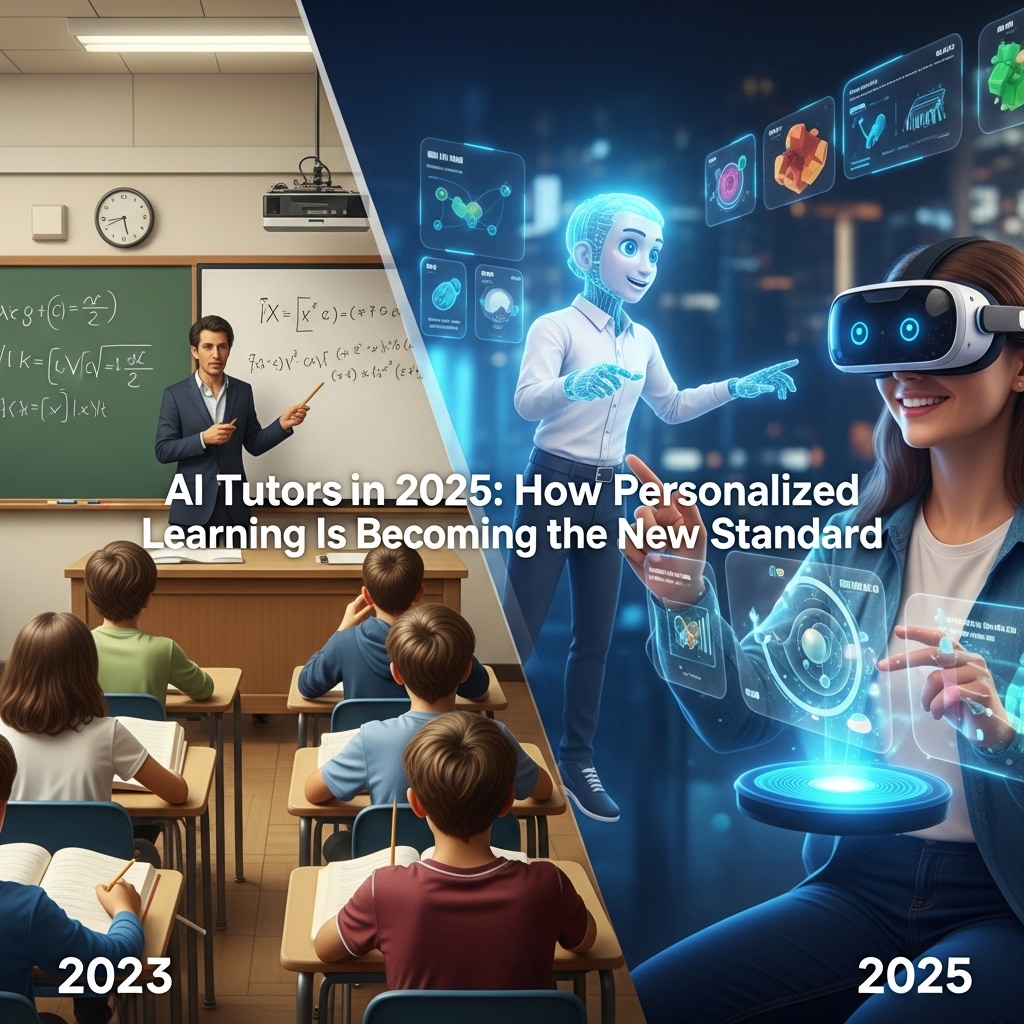
Adaptive Learning for Every Student
AI tutors now generate personalized study plans, explain concepts in multiple ways, and track learning gaps. Students get instant quizzes, video explanations, and step-by-step problem solving. Schools, colleges, and edtech platforms use AI-driven dashboards to analyze performance.
With multimodal AI, students learn faster, teachers teach better, and classrooms become more inclusive.
AI Tutors in 2025 — How Personalized Learning Is Becoming the New Standard
AI tutors stopped being a novelty in 2024–25 and are now an everyday classroom tool. Below is a tight, evidence-backed overview of why AI tutoring is scaling so fast, how it actually personalizes learning, and what educators and policymakers should watch for.
Quick snapshot
-
The AI-in-education market and adaptive-learning sector grew rapidly through 2024–25 as schools, publishers, and edtech vendors invested heavily in personalized tools. Mordor Intelligence+1
-
Large, education-focused products (for example Khan Academy’s Khanmigo) and major platform features (OpenAI’s Study Mode, Google’s Guided Learning) pushed AI tutors into mainstream use in K–12 and higher education in 2024–25. khanmigo.ai+2WIRED+2
What’s changed (why 2025 feels different)
-
Better models tuned for learning. LLMs and pedagogical layers now produce Socratic prompts, scaffolding, and formative feedback rather than only one-line answers. Tools emphasize guiding learners to reason through problems. khanmigo.ai+1
-
Content + curriculum integration. Publishers and platforms are embedding AI into curricular pathways so the tutor knows standards, scope–sequence, and skill hierarchies (not just answer retrieval). Large partnerships between content firms and cloud/AI providers accelerated this. Reuters
-
Proven adaptive pedagogy. Systematic reviews and experimental studies in 2024–25 report substantial learning gains from adaptive, AI-driven systems in many contexts. Meta-analyses show notable effect sizes for intelligent tutoring/adaptive platforms. ScienceDirect+1
How AI tutors personalize learning (the mechanics)
-
Learner model: continuous estimate of student mastery, misconceptions, speed and affect (engagement/frustration) derived from actions, answers, and time-on-task. U.S. Department of Education
-
Adaptive content sequencing: the system chooses the next task (remediation, practice, or challenge) to maximize learning efficiency. Coursera
-
Socratic & meta-cognitive prompts: rather than delivering answers, modern tutors prompt students to explain, reflect, or try a scaffolded hint—improving transfer and retention. khanmigo.ai+1
-
Teacher dashboards & formative insight: AI summarizes class-level trends (who’s slipping, which standards need reteaching), saving teacher time and enabling targeted interventions. cdn-dynmedia-1.microsoft.com
Evidence: do they actually work?
Multiple systematic reviews and recent empirical studies (2024–25) report positive impacts: adaptive AI systems and intelligent tutoring have been associated with higher test gains, increased engagement, and faster mastery on targeted skills. One comprehensive review found large improvements in outcomes where ITS/adaptive methods were used and well-integrated into instruction. ScienceDirect+1
Real-world scaleups — for example Khan Academy’s rapid expansion of Khanmigo usage across districts in 2024–25 — provide early evidence that schools are adopting these tools at scale and reporting classroom benefits when implementation is supported. Education Week+1
Typical use cases (2025)
-
Individualized practice: students work on tailored practice sequences with instant, targeted feedback. Coursera
-
Homework & revision coach: AI provides hints, explanation scaffolds, and practice plans that adapt across sessions. WIRED
-
Teacher augmentation: automating grading of low-stakes work, surfacing misconceptions, and generating lesson resources. cdn-dynmedia-1.microsoft.com
-
Language learning & remediation: personalized drills and conversational practice that adjust level and prompt types. Frontiers
Challenges & risks to manage
-
Equity & access. Without intentional rollout, AI tutors can widen gaps (schools with devices and broadband benefit first). Government and NGO partnerships are crucial to scale access. The Times of India
-
Pedagogical quality control. Not all AI outputs are pedagogically sound—alignment to standards, human-in-the-loop review, and rigorous evaluation remain essential. U.S. Department of Education
-
Over-reliance & skill erosion. If used as an answer machine, students may shortcut learning. New product modes (Socratic/Study Mode) try to counteract that but classroom norms matter. WIRED+1
-
Privacy & safety. Learner data must be protected; transparent models of how recommendations are made are increasingly demanded by educators and regulators. UNESCO
What good rollout looks like
-
Teacher-first implementation: train teachers to interpret AI dashboards and integrate suggestions into lessons. cdn-dynmedia-1.microsoft.com
-
Pilot + evaluate: run short pilots with clear outcome metrics (engagement, mastery, retention) and iterate. PMC
-
Equity measures: device programs, subsidized licenses, and community hubs so low-income students benefit. The Times of India
-
Policy guardrails: clear privacy contracts, curriculum alignment checks, and human oversight for high-stakes decisions. U.S. Department of Education+1
Bottom line
By 2025 AI tutors are no longer experimental: they’re an institutional tool for scaling individualized instruction. When designed with strong pedagogy, teacher partnership, and equity safeguards, AI tutors can raise learning outcomes at scale — but the how of implementation matters more than the what of the technology.
